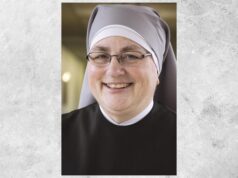
(Interview edited for length and clarity)
Set in 1967, “The Miracle Club” tells the captivating tale of three generations of lifelong friends, Lily (Maggie Smith), Eileen (Kathy Bates), and Dolly (Agnes O’Casey), all from Ballygar, a resilient community in Dublin, Ireland. Bound by a shared desire to win a pilgrimage to the miraculous town of Lourdes in France, renowned for miracles and healing, the women seize the opportunity when it arises. Their excitement is dampened by the arrival of Chrissie (Laura Linney), an old friend returning for her mother’s funeral, just before their trip. Despite Chrissie’s skeptical nature, she joins the journey in place of her mother, adding a touch of glamor and sophistication after her years abroad in the United States.
Laura Linney (“You Can Count On Me,” “The Squid and the Whale” and HBO’s “John Adams”) sat with Our Sunday Visitor to discuss the film, which opens in theaters July 14.
Our Sunday Visitor: Laura, why was joining the cast of “The Miracle Club” important to you? Why was it a film that you thought worth doing?
Laura Linney: I loved the script, and as you know, Maggie Smith and Kathy Bates are in the film. When you’re invited to join them in anything, it’s a real privilege! I was thrilled to be invited. The idea that I could go to Ireland was also exotic and wonderful for me. I just loved all the people involved in the production. These were very creative and inspiring people to be with.
Our Sunday Visitor: And what about your particular role in the film? Tell us a little bit about Chrissy. Was she a difficult character for you to put on or was she a natural role to play?

Linney: The story and what was provided in the writing was very rich and in many ways painful. It was interesting to examine what happens to someone who’s been wounded early in life by people they loved. And then as characters grow older and their lives intersect again, they meet in different circumstances, in a different era, with different cultural backgrounds. They discover what binds them together, whether they want it to or not.
The ability to work through heartache, real deep heartache and come out the other side … well … I wish that it happened more than it does. I do believe it can happen. I’ve seen it happen in my own life. I’ve seen it happen with others, but it’s not easy. But when your heart is open, when you allow others to change, when you’re able to let go and step into a new period of your life, you can see things differently and see people differently. As an actress, it’s a wonderful thing to be able to play such a dramatic and delicate role.
Our Sunday Visitor: How much familiarity did you have with Lourdes before the story?
Linney: Wow … none. I’m not Catholic, so I knew nothing about Lourdes. I knew a little about Bernadette, but I knew nothing about Lourdes. I’d never heard of it; I didn’t even know it existed. I wish we had gone there (we filmed everything in Dublin).
But learning about Lourdes was fascinating: The fact that there is such devotion there; that Lourdes means so much to so many different people in so many different ways; and the fact that it is culturally such a powerful place. And then to see how commercialism can sort of wedge its way in there. How do you deal with — how do you reconcile that? Because if I was there, I’d buy a trinket too, you know? I would want a glow-in-the-dark Virgin Mary!
Our Sunday Visitor: Part of what makes “The Miracle Club” so compelling is that it captures the heart of what it means to go to Lourdes: everyone who goes takes with them something that needs to be healed. Could you share a little more about how the film portrays this kind of encounter?
Linney: You have to sort of hold your pain and acknowledge it before it can be let go. One thing I’ve learned over and over again — doing what I do as an actress — is learning how to sit in discomfort. And learning how to trust that discomfort is leading me to a better place. Not to succumb to it, not to drown in it, but to be still within it and let things catch up with themselves.
In this story, there are four women who have been sitting in discomfort for a very long time. But there are also the wonderful heartwarming moments where comedy comes out of such awkward, painful situations. I always find that comedy and laughter are really such a survival mechanism that we’re given in order to release a little bit of truth. I find that comedy sort of sticks its finger into truth a little bit, and it’s so truthful that then we, out of joy and relief, delight in witnessing something that is true. Those two worlds coming together is very human to me.
Our Sunday Visitor: Were there any moments that you considered really a highlight of the film? Any moments that were just favorites of yours?
Linney: You know, I loved working with everyone on that movie so much. I mean, from Maggie Smith to Kathy Bates and Marco Halloran (who played the priest and has become a dear friend … he’s just lovely) and Aggie O’Casey, who is a remarkable young actress … I guess that’s the thing about the arts, because the arts came from religion, really, there is a sympathetic relationship there.
There’s a relationship between spirituality and the arts, which I’ve always deeply believed in. And you know, though I was not raised in a church (I was raised in theater), I think there are very similar aspects in those communities.
Our Sunday Visitor: Hearing you mention this communal aspect of the film resonates because when you’re on a pilgrimage, you’re with a group of people for a short period of time. But it’s very intimate and it generates a kind of companionship that’s unlike the other relationship. What do you make of the film’s crux, which is a pilgrimage?
Linney: I like to call that the invisible string. The invisible string connects you to a group of people that you go through something with. And it’s there. And it’s there forever. You are connected to each other. And every once in a while, you can tug on the string, and you know someone will answer back.
There’s something about travel and leaving what you are, what defines you, and what you’re most comfortable in and putting yourself in a different environment. What you learn about yourself that you didn’t even know was there. I think that’s pilgrimage in some ways, isn’t it? To go learn about the parts of you that you didn’t even know existed?
Our Sunday Visitor: Other than pilgrimage, what was one of the important themes of the film? What is “The Miracle Club” really about?
Linney: Oh, I’m very bad at themes. But I can certainly say, I think it’s about family and forgiveness and growth. I think the women in the film discover how deeply they really do care about each other. The more people have ill feelings towards each other, often means that underneath there is a real desperate need to connect. There’s an expression that I know that if you’re angry for more than 10 minutes, it’s not really about what you think you’re angry about, it’s about something else. And figuring out what that “something else” is, when there is betrayal and trauma and a sense of displacement, that can inform the rest of your life in a very intense way.
So, in some ways, it’s about freedom. All of them are liberated from either their own sense of who they thought they were or what they thought they were capable of doing. When you take responsibility for some of the actions that perhaps you’re not so proud of, that is so liberating. But first, you have to recognize it; first, you have to know what it is. And that sometimes takes a long, long time. We are all haunted by pain in some way. But I think you have to deal with the haunting.
And there’s also something just so wonderful about water, the symbolism of water … being washed and being cleaned. I love all of that symbolism.
Father Patrick Briscoe, O.P., is a Dominican friar and the editor of Our Sunday Visitor.
The Dialog provides readers news to your inbox with the Angelus e-newsletter. Sign up here for a free subscription to the Angelus.







